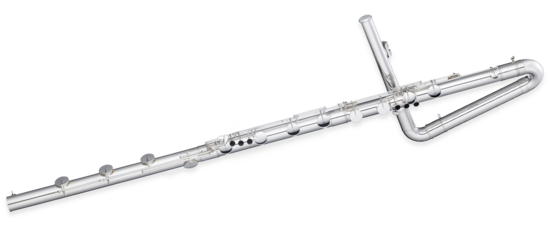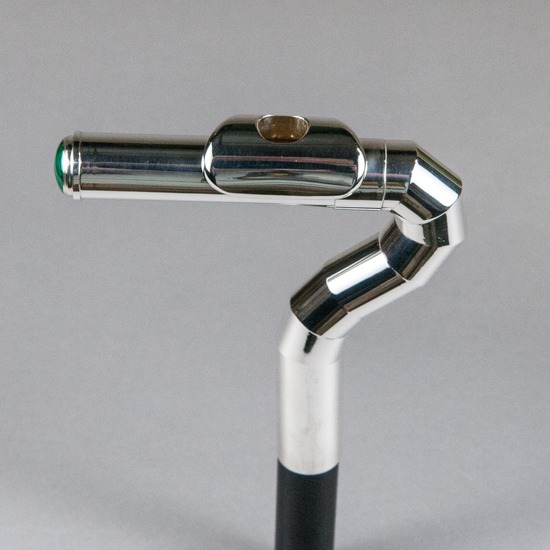Vertical Flutes
post by jefftk (jkaufman) · 2022-10-18T01:40:01.254Z · LW · GW · 4 commentsContents
4 comments
The standard (" transverse") flute has pretty terrible ergonomics: your arms are way out to the side. Most woodwinds use a much more natural playing position where the arms are comfortably in front of you, including some (" end-blown") flutes. In the case of the flute, however, this gives a pretty different sound. Could we give up on the simple cylindrical design of the flute to get some thing that sounds like a transverse flute and plays like a transverse flute but is more ergonomic?
Yes! By putting a bend in the head joint it's possible to do just that. This is a common configuration for bass flutes and lower:

Jupiter
JBF1100E bass flute

Pearl PFC-905 contrabass flute
You can get a replacement head joint for a standard concert flute, though it's pricy:
I don't know why this isn't more common? Do people not like that it looks unusual? Katherine Saenger looked into this some (pdf) and claims that the main options for concert flute today don't sound great but better-sounding ones are possible. Has anyone tried these?
4 comments
Comments sorted by top scores.
comment by nim · 2022-10-18T15:13:23.571Z · LW(p) · GW(p)
How would you efficiently damage the hearing of the player next to you if you weren't projecting most of your sound straight into their ear? (mostly joking)
Seriously though, at least in low brass, the direction that the bell points has an impact on how an instrument sounds to the audience. Tubas designed for use indoors tend to have bells which point upward, whereas tubas and sousas designed for use outdoors tend to point toward the audience. I would not be at all surprised to discover that flute tone is similarly variable based on whether you're pointing the thing at the room or at the floor.
I suspect that your question has a simpler answer, though, which you allude to in your post: The special heads are rare and expensive. They're uncommon, pricey, and do not clearly convey an immediate advantage. There's probably a learning curve to them, as Oural mentioned -- not only will the player have to rotate all their hand movements by 90 degrees to play a vertical flute, but the other body motions, changes to posture and breathing which subtly alter the sound of the instrument, have to follow suit as well.
I think to change this status quo, the most impactful thing to do would be to publish a free 3D printable vertical headjoint for whatever flute is most common in middle and high school bands/orchestras, and socialize the concept on platforms where high school and university music students are likely to see it. 3D printing is accessible enough, especially in academic settings, that it could capitalize on the "that's neat, I'd like to try it if I can get access to one" impression that a novel instrument tends to get from musicians. I think the collective feedback of a large group of intermediately skilled yet relatively adventurous musicians would show trends of how the vertical flute "really is".
Sadly, users would likely have to 3D print the entire head joint -- an adapter placed between the head joint and body of a existing flute would change the length of the instrument, and thus alter the pitch. However, 3D printing works ok for instrument parts which don't have to resonate too much -- it's been used for brass mouthpieces for awhile now, and can be comparable to other plastic mouthpieces if you finish the surface nicely.
Replies from: jkaufman↑ comment by jefftk (jkaufman) · 2022-10-18T19:32:12.085Z · LW(p) · GW(p)
I would not be at all surprised to discover that flute tone is similarly variable based on whether you're pointing the thing at the room or at the floor.
With a flute almost all the sound comes out at the embouchure hole and the topmost currently open body hole. Not very much comes out the end of the instrument. (This is from practice micing flutes for live performance.) This makes me think where the end is pointed wouldn't be very important?
Replies from: nim↑ comment by nim · 2022-11-04T16:49:57.646Z · LW(p) · GW(p)
That's a new and interesting fact to me! My mental model of why the keys on instruments change their pitch is that moving the open holes in the tube changes the length of the tube, which changes the wavelength of sound that's emitted. In retrospect, this formulation doesn't actually fit well with my model of "sound comes out end of tube" at all, but does fit well with "topmost open body hole".
Modeling the sound as coming from the first open hole does suggest another reason that formally trained flautists might dislike vertical flutes, though: changing which hole is open would cause the apparent source of the sound to move along the body of the flute, so changing from "sounds like it's moving from side to side" to "sounds like it's moving up and down" might be jarring.
comment by Orual · 2022-10-18T14:36:13.886Z · LW(p) · GW(p)
My experience is that there's a huge amount of conservatism among classical instrument players.
One part is the sound change. If something changes the sound of their instrument in a way that isn't clearly positive it's very hard to convince people to switch to it. Sometimes this is pretty rational, (I don't think anyone thinks plastic brass instruments sound better) but other times it's a kind of superstitious audiophile sort of logic. For a flute, I think bending a formerly straight tube will always have some effect on the sound. If the tube is already bent one or more times (as a bass flute must be even if the play orientation of the concert flute is maintained, because you have to have a certain length of tube which would be completely unwieldy if kept straight), a different or additional bend is lower impact. We see this with brass instruments, where you can fit a tuba into a significantly smaller volume without changing the sound significantly, so long as the bell is not shrunk too much and the mouthpiece remains the same size, simply by bending the tubing in more and different ways, so that the overall lengths of the main tube and each of the valve tubes remain the same.
The other part of it is muscle memory; people have spend thousands of hours playing an instrument with a very specific configuration. They don't want to change how they hold something even if it would be more ergonomic because it would mean a bunch of re-learning, not on their main instrument. I've encountered this myself as a pianist. If you change anything about the piano keyboard too much, it trips me up. The whole part of my brain that handles the movements for piano relies on the keys being in very specific positions relative to each other (and me) and responding to my touch in specific ways. I once botched a recital because the piano provided had too high an initial actuation pressure on the keys and I hadn't been able to do enough practice on it to adjust. I would love a piano with keys about 60% the size of the standard ones, because I have small, slender hands. But actually switching to such a piano if it were to be made would be a painful process, and getting up to speed on it would likely mean that I would lose facility with pianos that have standard-size keys.
The exceptions I've seen to this, where ergonomic innovations have been readily accepted, are triggers on trombones and 4th valves on some other brass instruments. Those have become very popular over the years. I think the reason for the difference is that a trigger or 4th valve is completely optional to use. You can still play everything exactly as you would have before, you just now have an additional option which makes certain things more convenient. There's a gradual adjustment process where you integrate the new feature into your play and you don't experience a phase where you feel hampered by the change. That makes switching costs much, much lower.
